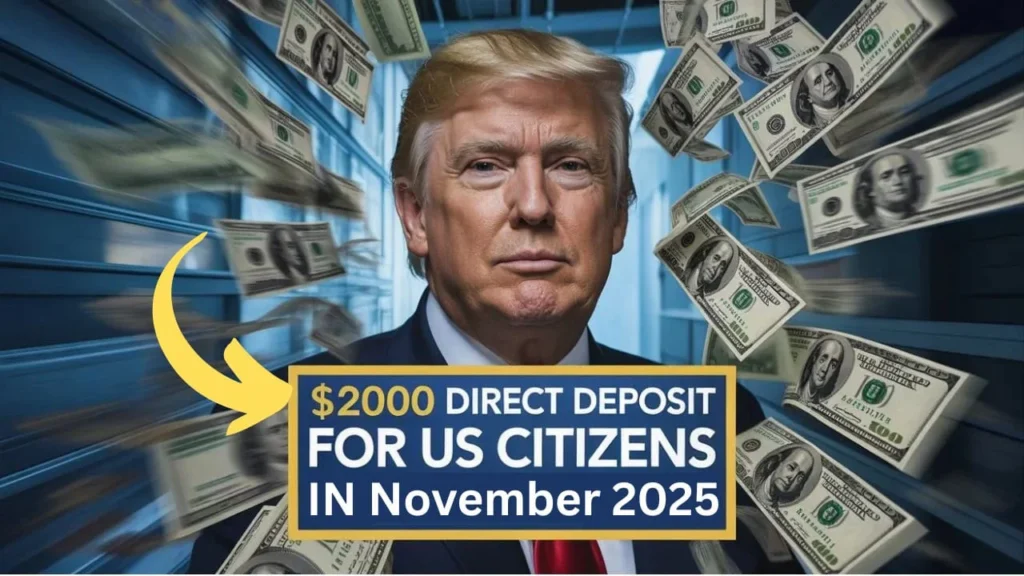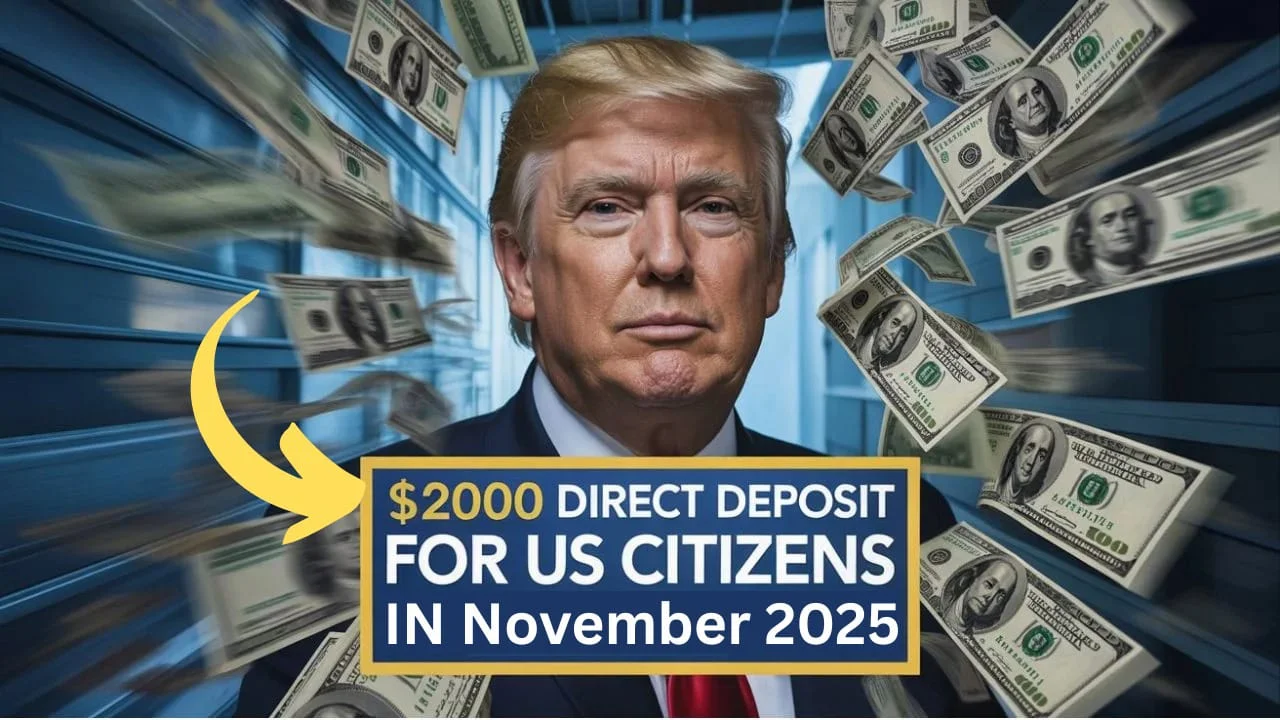As 2025 nears its end, anticipation is building across America about a potential $2,000 direct deposit payment aimed at providing relief for millions of citizens struggling under inflation and rising costs of living. With prices for groceries, gas, and housing still above pre-pandemic levels, the federal government is reportedly preparing another round of direct payments that could arrive as early as November 2025.
Also Read : Top 10 Rare U.S. Coins Collectors Are Desperately Hunting for in 2025
While official confirmation is still pending, several government budget drafts and IRS reports indicate that the administration may authorize a new round of stimulus-style deposits. The proposed plan is designed to help low-income households, senior citizens, and working families recover from ongoing financial strain. Here’s what’s currently expected about eligibility, payment timelines, and how these deposits would be distributed.

Why a New $2,000 Direct Deposit Is Being Discussed
Since the start of 2024, inflation has remained stubbornly above 3 percent, while wages have struggled to keep pace. Many Americans continue to rely on credit cards and short-term loans to cover essential expenses. In this environment, a $2,000 direct deposit could function both as a temporary relief measure and as a stimulus injection to strengthen domestic spending before the 2025 holiday season.
Also Read : Yellowstone Season 7 Trailer 2026: Release Date, Cast, and Every Latest Detail Fans Need to Know
According to early briefings from Treasury analysts, the plan mirrors previous economic-impact payments: deposits would be sent directly to eligible bank accounts via the Internal Revenue Service (IRS) using the same payment infrastructure built during the pandemic.
Expected Eligibility Requirements
Although official IRS guidance will determine final qualifications, the 2025 proposal reportedly follows a familiar framework. Expected eligibility rules include:
- Income limits: Individuals earning under $75,000 annually or joint filers under $150,000 could receive the full $2,000. Partial payments might phase out for incomes up to $100,000 (single) or $200,000 (joint).
- Citizenship and residency: Must be a U.S. citizen or lawful permanent resident with a valid Social Security number.
- Tax-filing status: 2024 tax returns must be filed by the IRS cutoff date — typically April 15 2025 — to confirm eligibility and banking details.
- Dependents: Parents or guardians could receive additional $500–$1,000 for each qualifying child under 17.
- Seniors and disabled individuals: Social Security and SSI recipients are expected to be included automatically, as in prior stimulus rounds.
Those who did not file taxes but received federal benefits (like SSI or SSDI) may still qualify; the IRS generally pulls that data from the Social Security Administration.
Expected Payment Dates
If Congress finalizes the funding by mid-October, direct deposits could begin rolling out in the second week of November 2025. Historically, payments are issued in waves over several weeks depending on how recipients receive benefits:
- Direct deposit: 7–14 days after the Treasury authorizes disbursement.
- Paper checks: 2–4 weeks later, mailed to registered home addresses.
- EIP cards (prepaid debit): For unbanked recipients, expected 3–5 weeks after the deposit phase.
Recipients can track payments using the IRS “Get My Payment” tool, which is expected to reactivate once official distribution begins.
How the IRS Will Handle Distribution
The Internal Revenue Service will oversee the deposit process, working with the Treasury Department and Federal Reserve. Payments are expected to be labeled as “IRS TREAS 310 – TAX REF” in bank statements, the same format used during earlier stimulus waves.
To ensure accurate delivery, Americans should:
- Update direct-deposit details in their 2024 tax return.
- Check bank information on IRS .gov once payment tracking goes live.
- Avoid scams—the IRS never contacts taxpayers by phone, text, or email requesting account verification.
Economic Impact and Political Context
This potential direct-deposit program comes amid renewed debate in Washington about how to sustain economic growth while tackling public debt. Supporters argue the $2,000 relief could stabilize consumer spending, reduce credit-card dependence, and soften a predicted slowdown heading into 2026. Critics counter that further stimulus could reignite inflation and strain federal finances.
Regardless of the politics, the plan carries major significance for ordinary Americans facing persistent financial pressure. Economists estimate that even a single-round payment could temporarily lift household confidence by up to 10 percent in lower-income brackets.
How to Prepare for a Possible Payment
To avoid delays or missed deposits, citizens are advised to take a few preparatory steps:
- File 2024 taxes promptly and electronically.
- Link an active checking account with correct routing numbers.
- Keep IRS and SSA contact details current.
- Watch official government updates—avoid misinformation circulating on social media.
If approved, the IRS will automatically distribute funds using your latest filed tax information; there will be no separate application process.
Who Might Be Left Out
As with previous payments, certain groups may not qualify, including:
- Non-resident aliens and individuals without a valid SSN.
- Dependents claimed on another taxpayer’s return.
- Individuals with unpaid federal debts (these could trigger partial offsets).
However, lawmakers are reportedly exploring a waiver for federal student-loan holders to ensure they receive full payments despite outstanding balances.
How This Compares With Past Relief Programs
The structure resembles earlier stimulus packages, but with updated safeguards. The 2025 version would use real-time income data from 2024 returns to reduce overpayments. Direct deposits are also expected to move faster thanks to improved IRS digital processing infrastructure.
Economists note that this payment isn’t technically a “stimulus check” but a targeted inflation-relief deposit, meaning it may not repeat quarterly.
Expected Timeline Summary
| Step | Date (Expected) | Details |
| IRS Budget Approval | October 2025 | Congress finalizes relief allocation |
| Payment Authorization | Early November 2025 | Treasury begins issuing direct deposits |
| First Wave of Payments | Mid-November 2025 | Direct deposits reach major banks |
| Paper Checks / EIP Cards | Late November 2025 | Mailed to remaining recipients |
| Final Distribution | December 2025 | Completion of all verified transactions |
FAQ Section
Q1. When will the $2,000 direct deposit be released? The first wave is expected in mid-November 2025, pending final congressional approval.
Q2. Who qualifies for the payment? U.S. citizens or lawful residents earning below $75,000 (single) or $150,000 (joint), including most Social Security recipients.
Q3. Do I need to apply? No application is required; IRS deposits will be automatic for eligible taxpayers.
Q4. Will non-filers receive it? Yes, if they receive federal benefits like SSI or SSDI, or if they submit a non-filer form when announced.
Q5. How can I track my deposit? Through the “Get My Payment” feature on IRS.gov once it reopens.
Q6. Are paper checks still available? Yes, but they will arrive several weeks after direct deposits.
Q7. Is the payment taxable? No, like prior stimulus payments, it’s not considered taxable income.
Q8. What if my bank account has changed? Update your information on your 2024 tax return or through the IRS online portal.
Q9. Could the amount change? Congress could modify the $2,000 proposal before final passage, but that’s unlikely according to current drafts.
Q10. Where can I confirm official updates? Only at www.irs.gov and www.treasury.gov.
Disclaimer: This article summarizes publicly available financial proposals and Treasury discussions as of October 2025. Final program details are subject to congressional approval and IRS implementation. Always verify eligibility and instructions via official government sources.

1 thought on “$2,000 Direct Deposit for U.S. Citizens in November 2025: Expected Eligibility, Payment Dates & IRS Guidelines”